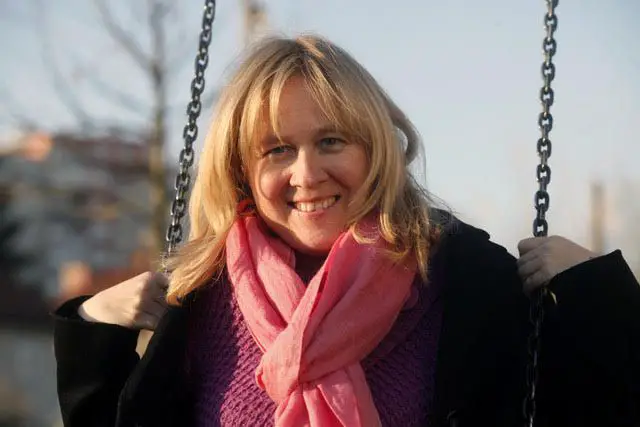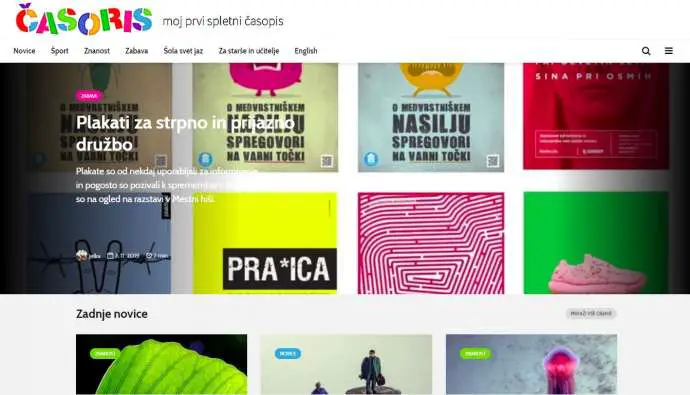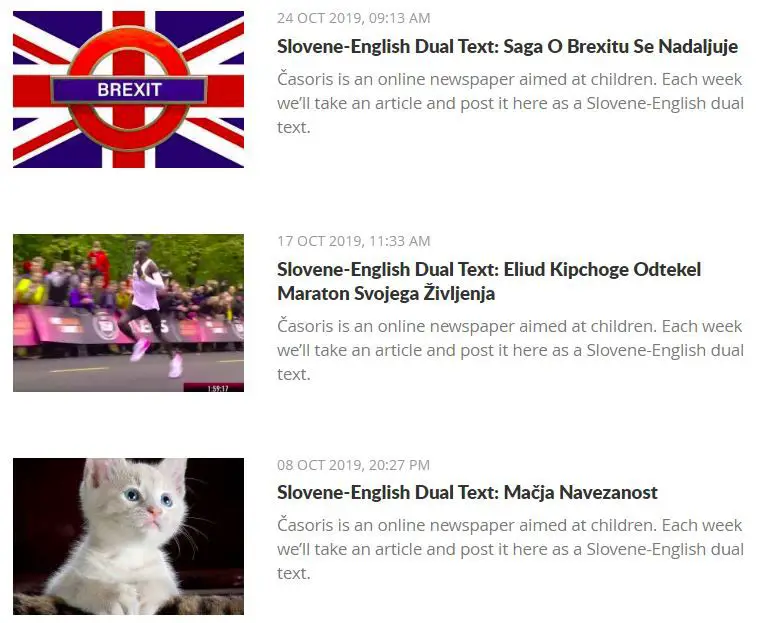Regular readers of TSN will probably know we run a weekly dual text, in English and Slovene, to encourage you to read more of the language. This text comes from Časoris, a Slovenian news website for children. Since the website won an award last week, as detailed below, we thought it’d be a good time to share more about the project, and so sent some questions to one of the people behind it, Sonja Merljak Zdovc, and she was kind enough to reply.

Source and subject, Sonja Merljak Zdovc
How did you come to start Časoris?
It was created in April of 2015 – in the aftermath of January’s terrorist attack on Charlie Hebdo in Paris. At the time, many parents were wondering how to explain what happened to their children. An article about how a French newspaper for children did just that landed in my Facebook feed, and it reminded me that we have no such medium for children and their parents in Slovenia. That’s how it occurred to me that I could create it.
I strongly believe that children can and want to understand the news if it is put in context for them, and presented in kid-friendly language. With Časoris I am trying to help them to understand the news, to think critically about what they’re reading, and to apply their knowledge to the real world.
More personally, I love being a journalist. I believe this is the most beautiful profession in the world. At the time when I became one, we would say that we became journalists because we wanted to bring peace to the world. Just like the women in Miss World!.
However, in the last decade journalism became a failing profession. And the media, so crucial to democracy, began to lose readers, listeners, and viewers. Children growing up today live in the world of Snapchat, Instagram and You Tube, and do not see their parents read newspapers or watch the news as we did.
With a generation of readers already lost, I began to think if I could do anything to help save the profession I love so much. I came up with an idea: an online newspaper for children.
Online, because children are on the web, and a newspaper because I wanted them to read serious news, not just the fun staff.
Časoris is aimed at young children, those who won’t read the news on their own. But they are trusting souls and if the adults they respect, their teachers and parents, tell them it is good to read the newspaper, they will listen.
This way we hope that when they become teenagers they will develop a habit of reading reliable sources of information. And when a popular You Tuber suggest that a EU directive will ban memes, they will know where to double check their facts.
Who produces it, and who is it aimed at?
It is produced mostly by me together with a team of dedicated writers who contribute as much and as often they can. It is aimed at children aged 6 to 12 but we hear and are happy because of that that also older children read it and find it interesting.
Our readers like Časoris because it has short, interesting stories using relatively simple Slovene. Do you know if it’s used to teach Slovene as a foreign language?
I don’t know about that, but I have heard that some English language teachers use Časoris in their English classes. And I also know that some teachers from the States find it useful as it brings them the news from other part of the world. They value its different perspective on current affairs.
And of course, it’s read in some Slovene schools during classes.
Časoris recently won an award in Austria – what was that all about?
The project Stories of Children from around the World won the Intercultural Achievement Award in the media category. The aim of the project is to give a voice to the voiceless, in our case to children from other countries living in Slovenia and going to Slovenian schools.
The award means a lot, because our work has been recognized internationally. For a small media operation, which Časoris still is, this is really huge.
The award is financial, too, so it will be easier to start next year. Časoris does not have any systematic funding and we can never be sure if we’ll have enough support.
We respond to tenders and if we are successful we get funding for a project. Stories of Children from around the World, for example, was co-financed by Government Communication Office as part of the efforts to respect and welcome members of different ethnic groups, refugees and migrants.
You used to work at Delo. What have been the biggest changes in the Slovenian print media over your career?
Hm, that’s a difficult question. In Slovenia we could add political pressures to the digital revolution. In the past we had seen examples of politicians wanting to control the media. One of the biggest drops in subscriptions was directly related to that. The readers that left did not subscribe to other newspapers, they were lost for good.
The idea that the media must bring in a double digit revenue was also not helping. A media owner should have other interests at heart, not profit. A wise media owner’s interest is the public good through credible journalism. An example of such an owner is the The Guardian’s Scott Trust.
Finally, the internet caused a disruption that we are all still struggling with. Nobody has come up with a good business model for the digital online world, at least not a model that could be used widely. There may be some exceptions, but in general the majority of the media all around the world are under pressure.
I’m still waiting for a Netflix or Deezer for news, a solution that will allow me to pay a certain amount of euros per month and then access the stories I want to read across different media and platforms – behind a paywall or not. If there’s no paywall I still want to make a donation, but I do not want the hassle of making a donation or paying every time I want to read something. I believe that there are other people out there who feel the same, so I hope someday will have a technology that will enable this.
Are there any reasons to be optimistic about the future of the media in Slovenia?
I am not sure that the future of the media in Slovenia is very different to the future of the media in other countries, but for the peculiarity of our language, of course.
I definitely believe that as citizens we need quality media and good journalism, and I only hope that more of us will recognize the important role the media plays in democracy. If we want to keep the media, we need to be willing to spend the price of a cup of coffee a day on the media of our choice – online or offline, as a subscription or a donation.
It seems easy to say, oh, I do not need the media, I get my information on Google and Facebook. But how do you know which information you are getting and why if you don’t have something to compare it to?
When something happens and the media doesn’t report it, people say, oh where were the journalists, why did they not report it? What they don’t seem to understand is that journalists are professionals who need to pay the bills, just like doctors, teachers or lawyers. They cannot do their job for free. Somebody has to pay for their service. It is either us, the readers, or advertisers, foundations or the state through various subsidies.
We can say that everybody whose paying an electricity bill is already paying for the news on public broadcasters. But if only the public broadcasters remain, it means we have only one perspective. And sometimes that’s not enough. Then there is no media pluralism.
In the States, half of the journalism jobs were cut in the last 10 to 20 years. It’s no wonder so much stuff is left unreported.
You can learn more about Časoris on the site itself, and see our collection of dual texts here. Meanwhile, if there's a project in Slovenia that you think deserves some attention in the English-language media, please contact me at This email address is being protected from spambots. You need JavaScript enabled to view it., or find me on Facebook








